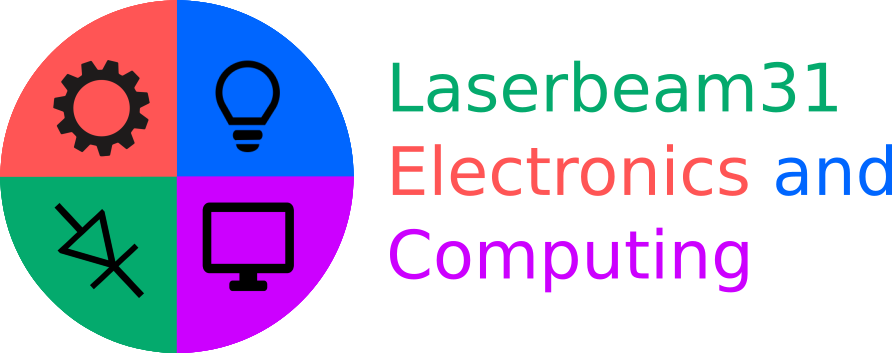
Theatre Lighting Intro - Hardware 4
[Theatre Lighting Contents Page]Now that we have explored the technology used to physically connect and control theatrical equipment, we can now explore in greater depth the exact types and principles of operation of the physical stage lights themselves. This section mainly focuses on incandescent stage lights which are the most common type employed for this application.
A section is, however, dedicated to LED lights. Such lights are often used to supplement conventional incandescent fixtures but it must be noted that their modes of operation and control are very different to those of incandescent lights: they are never and must never be connected to dimmer packs in order to achieve control. Instead, each LED light receives a source of non-dimmed mains power and is controlled by daisy-chaining a DMX data line to every individual LED fixture used. This is different to incandescent lights, which receive a dimmed supply of voltage from discrete separate dimmer packs which are in turn themselves controlled via DMX.
The definition of a "light" refers to any device which outputs useful visible radiation (light) from an inputted energy source; this is typically an electrical supply. Incandescent lights, which are the simplest and most common variety for theatrical purposes, achieve this by passing electric current through a thin metal wire (usually made of carbon or tungsten) enclosed in a glass capsule containing an inert gas atmosphere (typically argon or krypton) in order that the wire may not corrode. Now it is the case that any current-carrying wire heats up by a certain degree. If the diameter of the wire is reduced sufficiently, the aforementioned heating effect will cause the wire to glow white hot. This white glow is seen as useful light. However, the heat produced during this process is largely wasted energy, thus meaning that incandescent lamps have low efficiencies. This heat also causes the filament to eventually burn out ("blow") entirely.
An individual incandescent light bulb is shown below:

A typical incandescent lamp for use in domestic applications such as household room illumination is generally rated between 40w and 150w depending on the required light intensity. Such lamps are omnidirectional light sources which are generally placed high in a room to provide overall illumination. This means that for theatrical applications - which require directional, focused, light aimed at (specific points of) a stage - an incandescent lamp is not used alone but in a fixture which contains reflector and lens arrays to point the light in a uniform direction. A number of varieties of fixture exist, each intended for a different ideal application.
[Top of Section] [Top of Page] [Theatre Lighting Contents]
The PARcan is one of the most basic and least efficient forms of theatrical stage light. It offers little control with regards to direction of light other than providing a roughly aimed "wash" of light towards a stage. Internally, a PARcan consists of an incandescent reflector lamp placed at the end of a cylindrical metal tube. The reflector in the lamp and the cylindrical tube (whose length may be adjusted to alter the amount of beam spread) serve to create a roughly directional beam of light for overall illumination.
Below: an annotated photograph of a PARcan fixture:
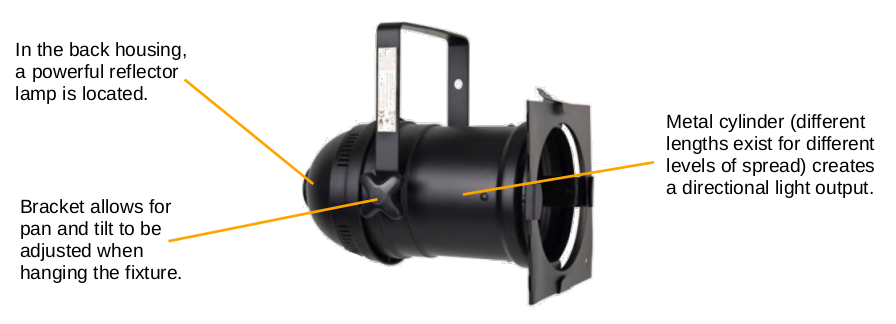
Below: a photograph of a lamp intended for use in a PARcan. The filament, reflector and glass housing are all one unit and must therefore be replaced together when the filament burns out:
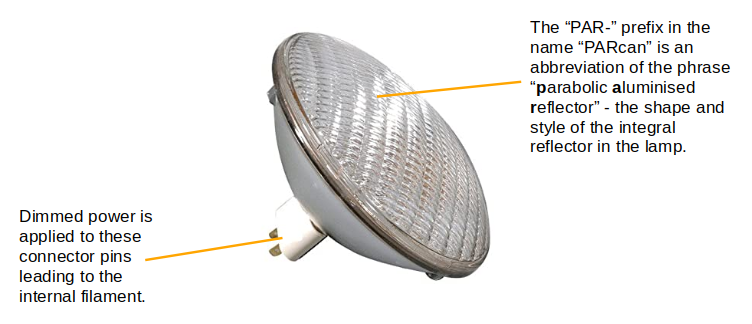
A number of different sizes of PAR lamp for use in PARcans exist. The designation numbers for such lamps range from PAR16 (smallest) to PAR64 (largest). In fact, these lamps were originally intended for use in early motorcar headlights but have since found further use in the theatre industry and also for some household lights. Size also affects the beam angle and overall light output. A lamp inside a medium-to-large PARcan is rated between 300w and 1000w. This is significantly more powerful than any domestic light bulb.
[Top of Section] [Top of Page] [Theatre Lighting Contents]
Box floodlight, or box light fixtures can be considered similar to PARcans owing to a similarly low efficiency and limited control of light output direction. These fixtures are highly optimised for providing an even wash of light from overhead (for example, they may be suspended from lighting bars above a stage, pointing downwards, as opposed to other lights such as PARcans which may be aimed at the stage from a front-on angle) and may also be used for house lighting - that which is used to illuminate the auditorium space itself during periods such as an interval or before/after a show starts, when the audience requires some moderate illumination for convenience.
A box floodlight simply consists of a light bulb placed in a metal box with a reflector (separate from the bulb, unlike in a PARcan) to direct the light in a downwards direction. An annotated photograph of a box floodlight (Strand Electric pat. 60) is shown below:
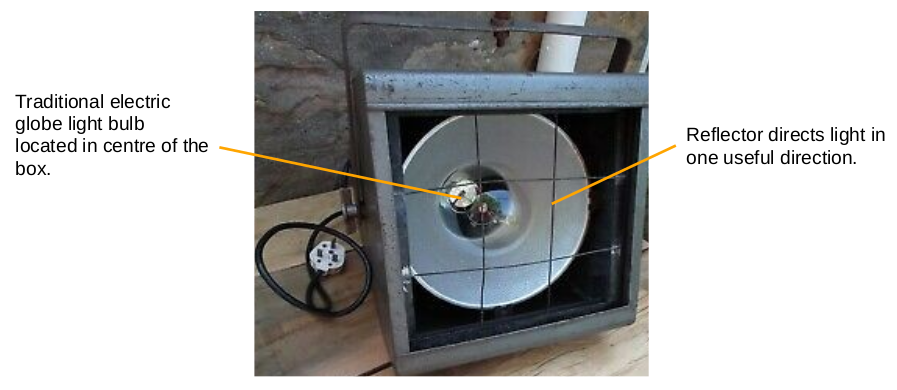
The lamp used in a box light such as this is similar to a household incandescent light bulb except that it is electrically and physically larger in order to achieve a greater light output. A photograph of such a bulb is shown below; observing this, one will notice clear similarities when compared with a conventional household light bulb:
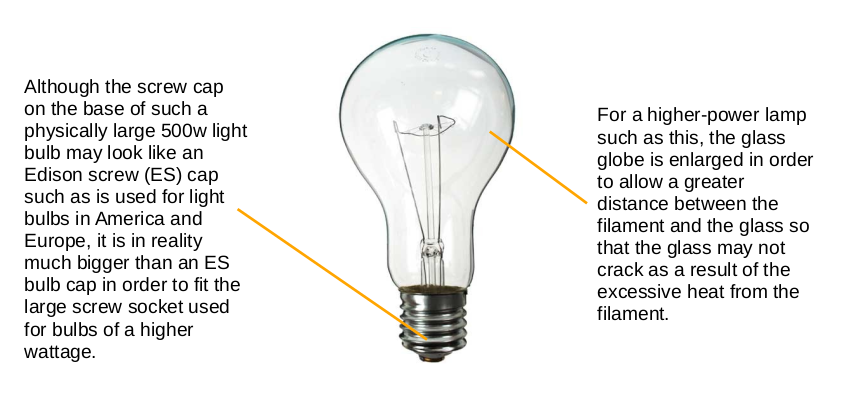
[Top of Section] [Top of Page] [Theatre Lighting Contents]
A Fresnel lens is named after its French inventor, Augustin-Jean Fresnel, who originally developed such lenses for directing the light output from lighthouses in a single useful direction. The great advantage of these lenses is that their stepped design means that they can be manufactured to be significantly thinner than a traditional concave/convex lens with the same focussing power.
Below: a diagram of a Fresnel lens. The rays from the point source of light are focused by a different degree depending upon which "step" of the lens they strike. The steps are angled such that the rays ultimately exit in one direction:

Fresnel light fixtures are thus named owing to their use of a Fresnel lens to create a directional light output. Inside such a fixture, a small but powerful capsule shaped incandescent lamp acts as a point source of light in front of a separate reflector. The reflector directs the light rays towards a Fresnel lens located at the front of the fixture. The rays then leave the fixture in one direction. A Fresnel light from Strand Electric (left), in conjunction with its internal lamp (right), is shown below:
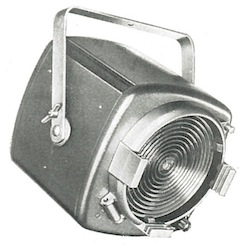
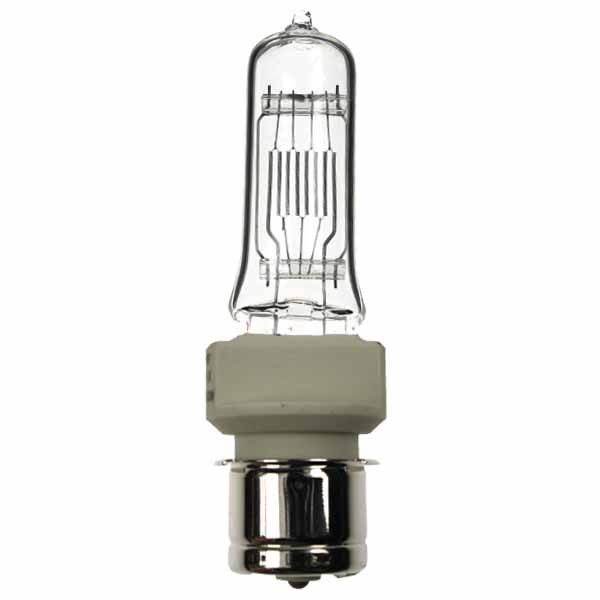
[Top of Section] [Top of Page] [Theatre Lighting Contents]
Profile light fixtures are a very versatile variety of theatre lights, allowing for extremely focused, directional light, or a wider wash of light as required. They also contain a more traditional lens array consisting of concave/convex lenses placed at a distance, similar to the layout of lenses in an optical instrument such as a camera or telescope. The light output can be controlled in a highly specific manner owing to the presence of an iris. This is a set of flat metal plates within the fixture which can "chop off" certain portions of the beam of light outputted by the fixture in order to precisely illuminate certain sections of the stage.
Being more sophisticated than any of the aforementioned theatre lights, profile lights are also internally more complicated. A small capsule bulb, essentially identical to that used in a Fresnel light, is placed within the focal point of a parabolic reflector. The rays emerging from the reflector are then reduced by the iris - certain sections around the edge of the aperture are obscured by the iris's metal plates. Finally, the rays, having been reduced by the iris, are focused by a lens array and emerge from the fixture. It is also typically the case that the spacing of the lenses at the front of a profile light can be adjusted such that the overall area of stage illuminated by the fixture can also be adjusted by this means.
Through the presence of the iris and the adjustable lenses, profile lights are useful for a wide variety of lighting applications. They are generally optimised for "projecting" light towards a stage front-on, being largely unsuitable for overhead illumination.
A Source 4 profile light - a modern industry-standard model - is shown below:
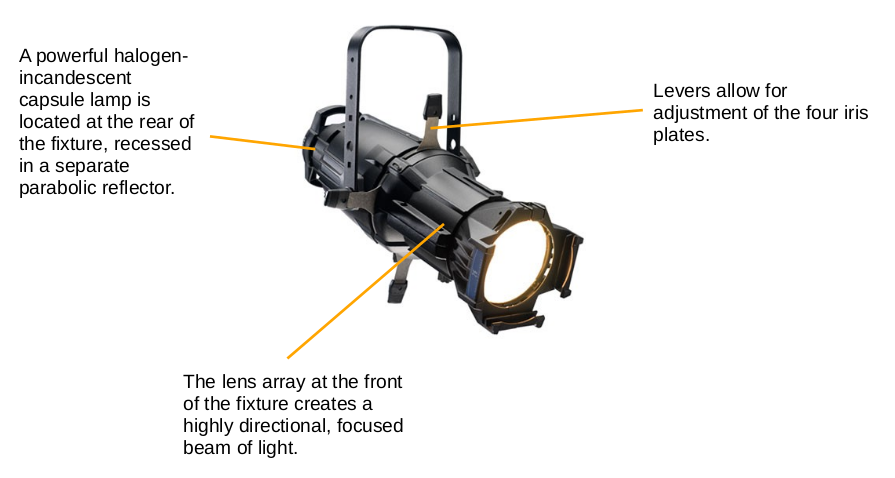
[Top of Section] [Top of Page] [Theatre Lighting Contents]
Followspot lights (also sometimes termed "spotlights") are fixtures with a very narrow beam angle intended to specifically illuminate one (or very few) characters on a stage. They are typically manned by an operator such that they are panned or tilted to follow the path of an actor moving across a stage.
Many followspot lights can be seen to be very similar in construction to profile lights. However, the main differences are as follows:
Since followspot lights are manned by a separate operator to the overall operator in charge of the main lighting control console, this operator is also generally in charge of turning his followspot light on or off (and, where necessary, dimming it) at the points during a show when it is needed. To accomplish this, the followspot is not connected to the main backstage dimmers (which, as discussed in Hardware 3: Lighting Dimmers, are controlled remotely from the central console) but to a source of constant power, such as a conventional square-pin utility socket. This power is then fed through a single-way dimmer module mounted to the stand or handle of the followspot, thus allowing it to be switched and dimmed by the operator.
A stand-mounted followspot light is shown below. Note the rear similarities in shape and style to a Source 4 profile light such as that shown in the previous section:
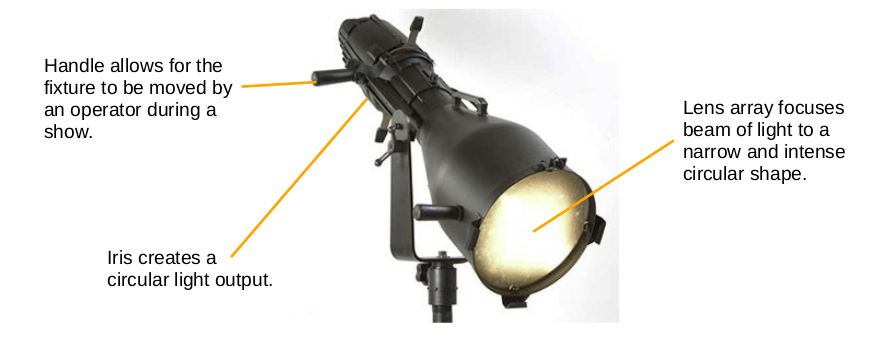
[Top of Section] [Top of Page] [Theatre Lighting Contents]
Once a fixture has been chosen for an aspect of theatrical stage lighting, it may be desirable to further alter the direction of light output (especially on fixtures which do not contain irises). Similarly, some shows may require that some lights be of different colours for enhanced effects.
A change in colour is obtained by placing a colour filter in front of the output of an incandescent fixture. Since incandescent light contains all the colours of the visible spectrum in its white light output, a filter simply restricts the wavelengths (colours) which are allowed to emerge. Theatrical colour filters are called "gels" and are based on a polymer construction.
Gels themselves are thin cellophane-like plastic sheets. As such, they require mounting in a simple metal frame, commonly called a gel holder. The gel sheet is cut to size depending on the type of fixture onto which it is to be mounted. It is then clipped into the fixture's gel holder. The gel holder then slides into the front of the fixture. It is important to note that different fixtures may require gel holders of different dimensions.
Below: a PARcan with a gel fitted in the front. The square metal frame around the coloured gel is the gel holder:
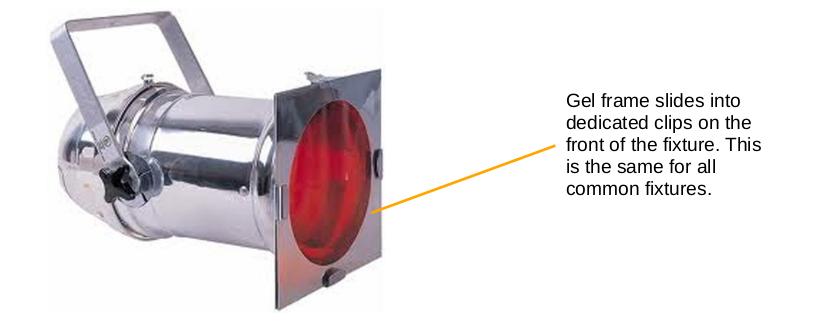
Although gels may look the same as simple pieces of coloured cellophane, they in fact have a significantly higher melting point than cellophane. This characteristic is of importance owing to the fact that incandescent light fixtures become very hot during operation. As a result, the use of standard cellophane in place of a proper gel will result in the undesirable melting of this inadequate "gel" in the front of the fixture.
Below: a selection of gel holders, each containing a different colour of gel, for a PAR64 PARcan fixture:
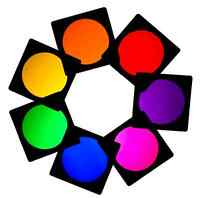
As well as colour filters, devices can be fitted to the front end of lighting fixtures in order to limit the direction of light output. These are generally used on fixtures such as Fresnel lights or PARcans which have no integral irises to limit the region of illumination. Such devices are called barndoors.
Below is shown a barndoor array mounted to the front of a Fresnel fixture:
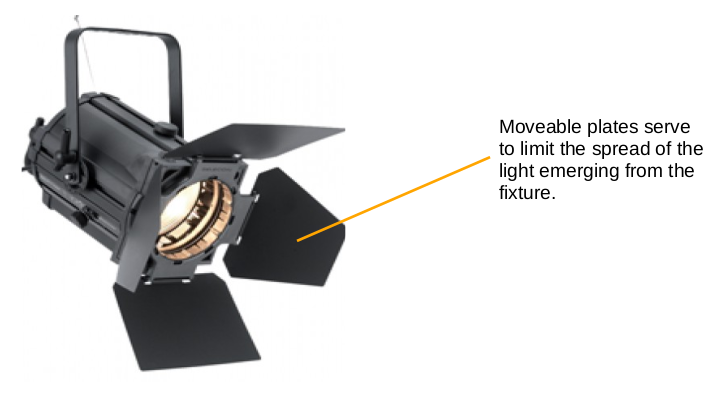
Further modification to the beam, similar in a way to that of the iris, can be achieved by using a GOBO. This term refers to a device which goes before optics. The "optics" term in the definition of a GOBO refers to the lens array. A GOBO consists of a thin metal sheet with a set of holes punched through it in strategic places such that a desired pattern is projected by the light once the rays, having been restricted by these holes, are focused by the optics.
Below is shown a GOBO which may be inserted into a fixture (typically a profile light since these have superior internal lens arrays, thus producing a sharper projected pattern). A projection pattern from another GOBO is also shown. Many different types of GOBO are available, including types with a custom-cut hole for a user-chosen pattern:

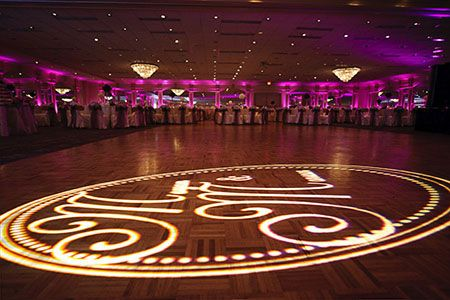
[Top of Section] [Top of Page] [Theatre Lighting Contents]
Until this point, all of the fixtures discussed are stationary types. These are generally the most common type of lighting fixture used in theatres. However, they carry the disadvantage that, should they require movement once suspended in (possibly inaccessible) places, a technician must manually move and focus them, often by using ladders or scaffolding towers. This is of inconvenience if lights must regularly be moved and refocused when new productions are carried out; it is inevitably the case that different productions require different lighting effects.
These problems can be mitigated, at least to a degree, by using intelligent moving-head light fixtures. These are fixtures which contain a lamp, reflector, and lens array, but also electric motors to automatically pan or tilt the body of the light in a certain direction. Sophisticated models also include motors to adjust the spacing/position of the lenses or iris and also an automatic device to change the colour filter in front of the output. These motors can be controlled remotely from a central console over DMX. Of course, a more sophisticated console may also be required since not only can moving-head lights be controlled with regards to their intensity, but they also have a plethora of other parameters (focus, pan, tilt, colour) - they are multi-parameter devices with a number of controllable aspects - which will be tricky to control with a standard dimmer console consisting exclusively of sliders (see Software 2: Operating a Lighting Console).
With regards to intensity control, it is also important to note that moving-head lights contain built-in dimming circuitry, thus meaning that they do not connect to dimmer packs but to constant power. For control, a DMX data cable is daisy-chained through every intelligent fixture in use such that each fixture's parameters can be individually controlled from the central console.
Below: a moving-head light:
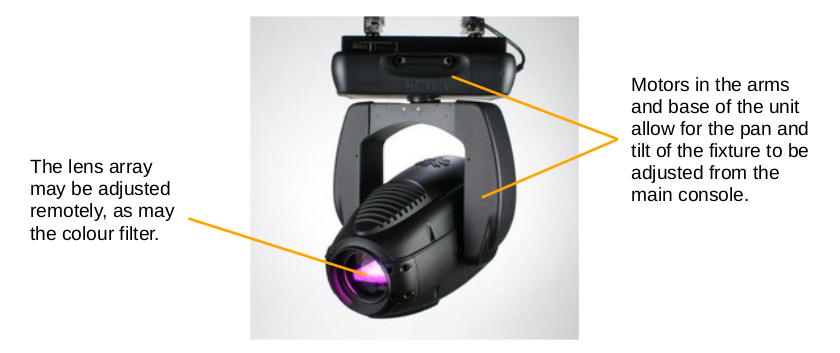
Moving lights are rarely used alone but alongside conventional stationary lighting fixtures. They are highly optimised for so-called "special" lights for illuminating specific areas of a stage for small periods of time, often in different colours. Moving lights can also be illuminated whilst moving instead of simply repositioning the head whilst they are switched off; this is used for additional effects in theatres and is often favoured in the music/disco industries.
[Top of Section] [Top of Page] [Theatre Lighting Contents]
Light-emitting diodes (LEDs) are a new, highly efficient variety of light source based around semiconductor chip technology. They are becoming commonplace for household lighting but are not used especially widely in the theatre industry. To further understand this lack of use, one must consider the fact that, unlike simple incandescent lamps, LEDs require substantial auxiliary circuitry in order to be run off even a normal mains supply.
LEDs require low-voltage direct current in order to operate correctly (around 3V per individual LED semiconductor). A mains LED light fixture must therefore contain circuitry to lower and rectify 240v AC mains power to a suitable level. The simplest means of lowering and rectifying mains voltage would be to use a transformer (lowers voltage) and bridge rectifier (converts, or "rectifies", the AC voltage to DC).
The main problem with this arrangement is that transformers operating at the 50Hz mains frequency are significantly less efficient than those operating at higher frequencies (in general, the efficiency of a transformer increases with frequency of input voltage). This is undesirable if the efficiency of the light is to be made as high as possible. Furthermore, the output produced by the bridge rectifier takes the form of fluctuating direct current, the exact pattern of which can be deduced by observing the graph of y=abs(sin(x)). This poses problems: the voltage will repeatedly fall to zero at 100Hz (once every half-wave), meaning that the LED will flicker visibly at a rate of 50-100Hz since the semiconductor chips have a very low thermal inertia. The problem is further exacerbated by the fact that the LED will generally only illuminate when the voltage of the abs(sin(x)) input exceeds its minimum threshold voltage, thus further restricting the portion of the fluctuating input waveform for which it can illuminate and exacerbating the flicker.
To eliminate the poor efficiency of the transformer at 50Hz, a transistor-based switching circuit can be employed at the first point in the circuit to significantly raise the input frequency to the transformer, thus reducing its requisite size by increasing its efficiency. After this, a rectifier is placed across the output of the transformer, with a capacitor in parallel across the output, in order to create a smooth flow of truly direct current through the LED. This is the basis of a switched-mode power supply.
Dimming of LEDs can be accomplished by the use of special solid-state direct current dimming circuitry utilising pulse width modulation (PWM). This is a technique by which the LED is deliberately pulsed on and off very rapidly (typically hundreds of times per second in order to overcome the aforementioned lack of thermal inertia on the part of LEDs) such that the on:off ratio of the flickering is made proportional to desired intensity. This results in an apparently dimmer output level to the human eye which cannot perceive the individual pulses of the rapid flickering. In an LED fixture which can dim, the constant mains power enters the fixture and is rectified and lowered before it undergoes PWM, and is finally output to the LED semiconductor emitter(s).
This circuitry used with LEDs renders them incompatible with existing theatrical dimming technology intended for conventional incandescent fixtures: the chopped mains sine-wave produced by a phase angle control triac dimmer such as that discussed in H3.4 - Phase Angle Semiconductor Lamp Dimmers enters the fixture before the voltage rectification and lowering stage, thus interfering with the normal operation of the components such as transformers, transistors, and capacitors, meaning that the lifespan of LED lights would be drastically shortened. Whilst there do exist LED lights which can derive power and (rough) PWM control from a triac-modulated mains supply, these are rare, expensive, unreliable, and do not offer particularly fine control of lower intensities. Ultimately, these factors mean that a total transition to LEDs would require extremely major replacement of control equipment (in order to accommodate fixtures with built-in PWM control as opposed to separate triac phase angle control dimmer packs) in a theatre, no doubt at great financial cost.
Furthermore, individual LEDs cannot be miniaturised into a very small area in the same way in which one may accomplish this with a tungsten filament lamp: the metal filament is a point source of light highly suited to use with reflectors and lenses. LED light cannot be focused in the same way thus reducing the potential of LEDs in replacing incandescent fixtures. Incandescent light is also excellent at rendering true colours because it is an almost perfect replication of sunlight. However, the same is not true for "white" LED light which is often distinctly tinted with blue. The consequences of this are twofold. First, the lighting provided by such lights, were they to be used exclusively, would likely be visually unimpressive. Second, the colours produced if a gel (colour filter) were placed in front of an LED fixture would not be true to those produced from the same gel in front of an incandescent fixture.
In spite of these problems regarding LED lights, they have certainly found use in the theatre industry. Unlike incandescent filaments, individual LED semiconductors are monochromatic (one colour) with regards to their light output. This means that if multiple sets of individual LED semiconductors (generally three: one red, one green, and one blue) are built into one fixture, by controlling the intensity of each set individually, any colour of light can be produced: the three primary optical colours are red, green, and blue. This renders LED fixtures useful for general variable coloured washes of light.
Since LED fixtures cannot be controlled by a conventional dimmed electricity supply, they are similar to the moving-head lights discussed earlier in that each fixture receives a source of non-dimmed mains power in conjunction with a direct connection to the DMX control line. This also allows for the fact that LED fixtures, as mentioned above with regards to the common use of three individually controlled coloured sets of semiconductors, are multi-parameter devices: unlike a simple dimmed fixture (single-parameter device), each component colour can be individually controlled from the central console in order to change the overall output colour of such a fixture.
Below is shown a typical LED fixture. LEDs are arranged behind circular plastic lenses. Most LED fixtures allow for the red, green, and blue components of their light output to be controlled individually:
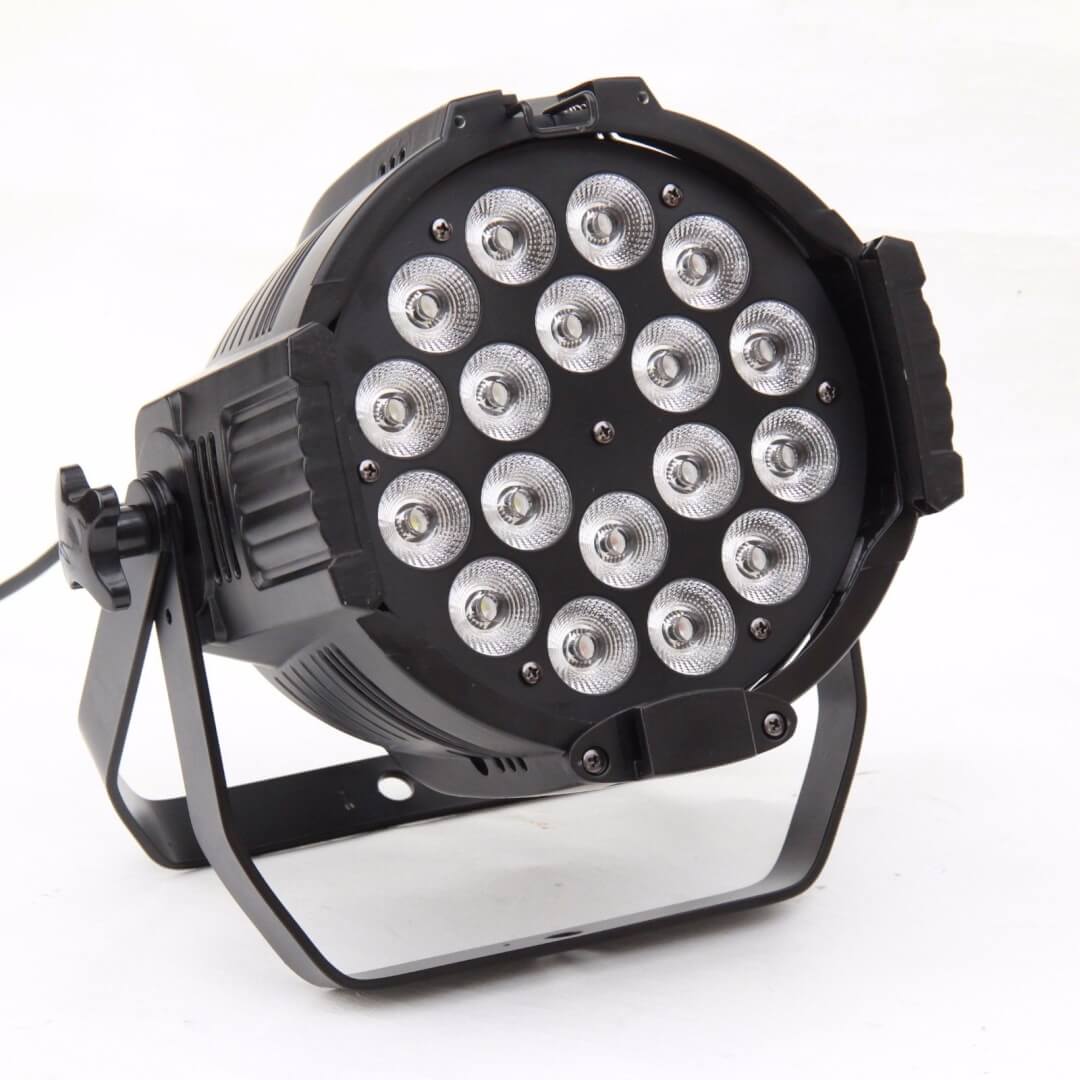
WARNING: LED lights (and indeed, moving-head lights) must never be connected to a source of dimmed power. This runs the risk of seriously damaging the fixture (and possibly the dimmer as well).
Below is shown a topological diagram of a theatrical lighting arrangement consisting of conventional dimmed fixtures, moving-head lights, and LED lights. The DMX line (blue) emerges from the console, loops through the dimmer packs but not through the dimmed fixtures themselves, through each moving-head light, and through each LED light. Whereas the dimmed fixtures receive dimmed power (grey line), the intelligent/LED fixtures receive constant power (black line):
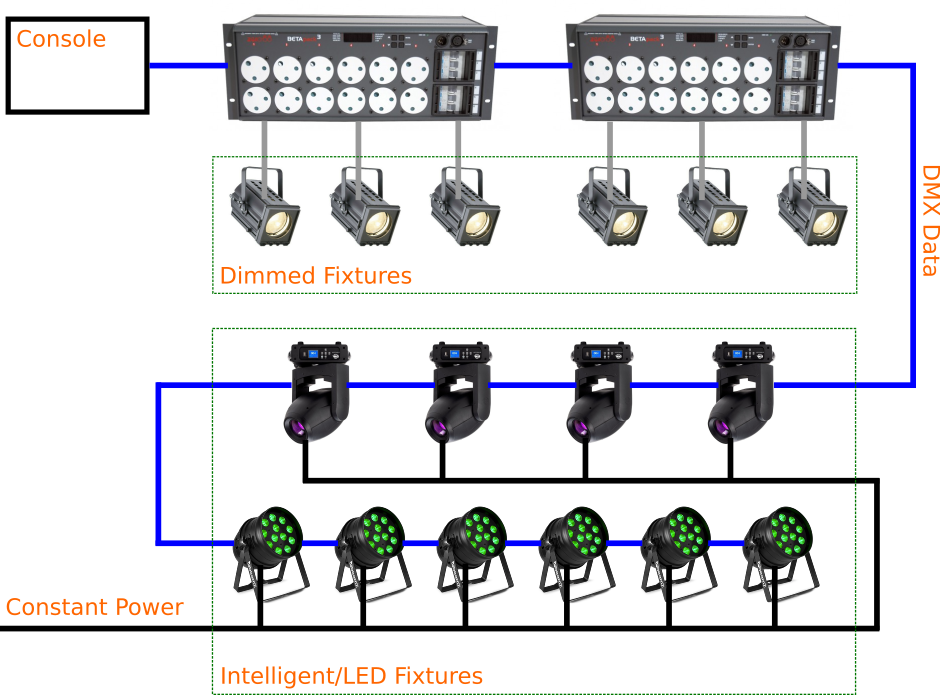
LED fixtures also find use for ultraviolet (UV) lights. UV radiation lies just outside of the visible spectrum of colours and is not especially visible to the human eye. However, numerous materials exist which glow very visibly when UV light is shone upon them (indeed, this principle of fluorescence is what allows fluorescent tubes - discussed in H4.10 - Gas Discharge Lights - to produce useful light). This phenomenon is employed in theatrical aspects such as costume or set such that a particular person or item may appear unusually luminous if coated in such a UV-sensitive material and illuminated by a UV light.
Incandescent fixtures can be made to output any visible colour of light with the use of a simple filter owing to the fact that the white light produced by a glowing filament contains all the visible colours of the spectrum. Therefore, any individual colour can be "singled out" by the use of a filter. However, incandescent light has a negligible UV component which means that if a filter which "singled out" UV radiation were placed in front of an incandescent light source in the hope that UV light would be produced, essentially no ultraviolet radiation would emerge. However, since an LED may be manufactured to emit any wavelength of luminous radiation, specialist UV LEDs do exist. If these are mounted into a theatrical fixture such as that shown on the previous page, ultraviolet light may thus be produced.
Some sophisticated LED fixtures may contain not only red green and blue LEDs such that any colour of visible light may be produced, but also a separate set of UV LEDs such that ultraviolet light may be produced from the same fixture if necessary.
[Top of Section] [Top of Page] [Theatre Lighting Contents]
Gas discharge lamps are very commonly used outside of the theatre industry. They are a well-established form of electric lighting with a superior efficiency compared with incandescent lamps - the other main light source currently in widespread use.
The principle of gas discharge is that when an electric current is passed through a sealed vessel containing a gas vapour, provided the voltage is high enough, the vapour will glow. The glow from this gas discharge is seen as useful light. Examples of gas discharge lamps in common use include:
Within the theatre industry, gas discharge lighting plays a somewhat less significant role with regards to stage lighting for two main reasons. First, as mentioned with regards to fluorescent tubes, discharge lamps take a considerable time period to "warm up" to their full level of light output. This is of inconvenience to theatrical applications which may require lights to be switched on and off quickly between scenes and is totally unsuitable for applications which require lights to be flashed or chased in rapid sequence. Second, gas discharge lamps will generally not work if an attempt is made to control them directly via conventional incandescent-orientated dimmer packs. Indeed, it is electrically difficult to lower the intensity of a gas discharge lamp at all, especially such that it dims down evenly and stably at very low intensities.
However, fluorescent tubes are frequently used in theatres, not as lighting during shows, but as work lights - those which are used during time periods for which a show is not running but during which rigging/preparation for a production is taking place. In these instances, there is no requirement for work lights to be dimmed and, since work lights are typically used for far greater time periods than show lights, the superior efficiency offered by the use of fluorescent tubes is highly desirable.
Some moving-head lights (discussed in H4.8 - Moving-head Light Fixtures) also utilise discharge lamps such as metal halide lamps for their light source instead of conventional incandescent lamps. High-power followspots also use gas discharge lamps. In these cases, dimming is achieved by means of a mechanical shutter arrangement.
Fluorescent tubes also find use for emergency lighting in theatrical buildings. This type of lighting is particularly important for theatrical venues which typically contain very few windows. This means that, in the event of a fire or power cut, the venue must be equipped with adequate emergency (battery powered) lights to illuminate emergency exits and important obstacles/routes within the building. The enhanced efficiency of fluorescent tubes in comparison with incandescent lights makes them ideal for operating off a limited electricity supply from an emergency lighting battery. More modern emergency lights now use LEDs - an even more efficient technology - as their light source.
[Top of Section] [Top of Page] [Theatre Lighting Contents]
"Patching" a light refers to the process of connecting it to power and, in the case of an intelligent or LED fixture, DMX data, once it is suspended from a lighting bar. This process is generally accomplished by connecting the light to power through one of many socket outlets mounted on a properly constructed lighting bar. Each socket on a lighting bar is in turn linked to a source of dimmed or constant electrical power.
Below: a wall-mounted theatrical lighting bar. Note the way in which each fixture suspends from the bar using a metal clamp clip and connects to electrical power via a socket on the bar itself. The lights may be focused and directed at a desired part of the stage during the rigging/patching process:
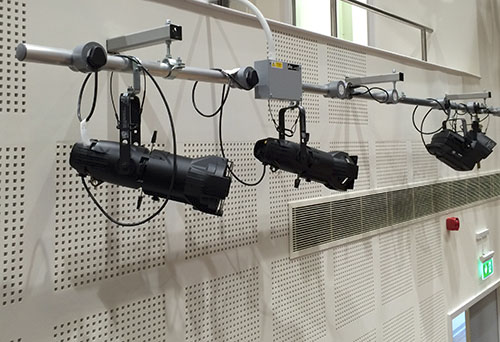
In some venues, each lighting bar socket is hard-wired to a dimmer circuit. This means that, unlike the dimmer packs shown in H3.5 - Theatrical Dimmer Packs which have output socket connections, backstage dimmer packs are internally hard-wired to sets of sockets on lighting bars, with no need for the user to adjust any cabling between the dimmer packs and the lighting bar sockets; each socket along the lighting bar is always connected to one triac dimming circuit (see Hardware 3: Lighting Dimmers). Below is a dimmer pack (modified Zero88 Betapack 3) intended to have its 6 dimmed outputs brought out through hard-wired internal terminals as opposed to pairs of front-mounted sockets:
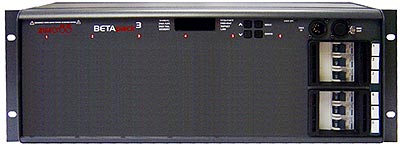
Another means of connecting bar sockets to power is by means of a switchboard-style patch bay. This means that, instead of each bar socket being permanently connected to a power source, it is simply brought out to a specific plug next to the backstage dimmer packs. These plugs can then be connected to dimmer packs with conventional front-facing outlets, thus providing power to the required bar sockets. This arrangement allows for the optional connection of certain bar-mounted sockets to sources of constant power if moving-head or LED fixtures are to be mounted instead of conventional dimmed incandescent fixtures. Furthermore, this arrangement also allows for greater versatility regarding which bar-mounted socket is connected to which dimmer channel. For example, if a certain channel of a dimmer pack fails, the light connected to it will cease to function. In a hard-wired state of affairs such as that discussed above, the only means of connecting the affected light fixture to a different, functional, channel is by ascending to the (possibly high) lighting bar and swapping the plug of the fixture into a different bar socket. This is assuming that spare sockets are even available along the bar. However, with the aforementioned telephone-style patching system, this problem can simply be resolved (at least temporarily) by moving the backstage plug corresponding to the bar-mounted socket into which the affected fixture is connected to a different, functional, dimmer channel without the need to make alterations at the level of the lighting bars themselves. Of course, it is still desirable to fix the faulty dimmer channel.
Below is shown a telephone-style patch bay using 15A round-pin plugs as a means of bar-socket-to-dimmer channel connection:
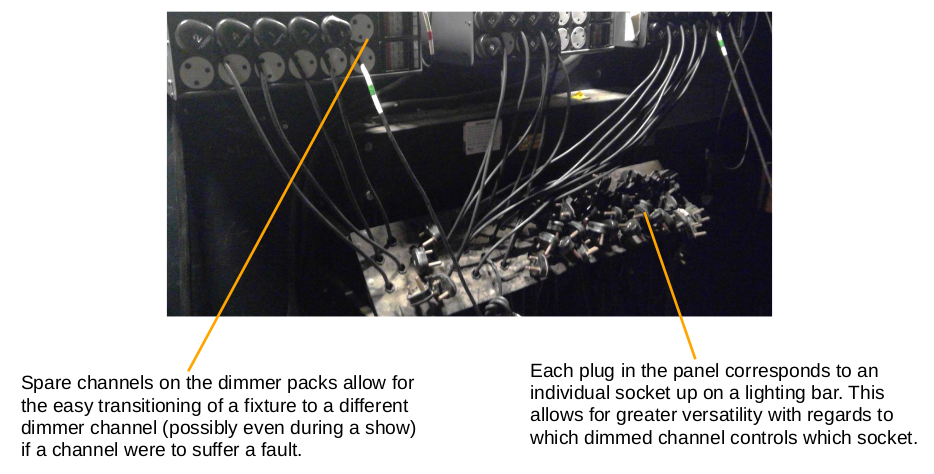
Some venues utilise CEEform or Powercon connectors both at the level of the lighting bars but also in the patch bay. Below is a modified Zero88 Betapack 3 such that it outputs dimmed power over miniature CEEform sockets instead of the more conventional 15A round-pin sockets:
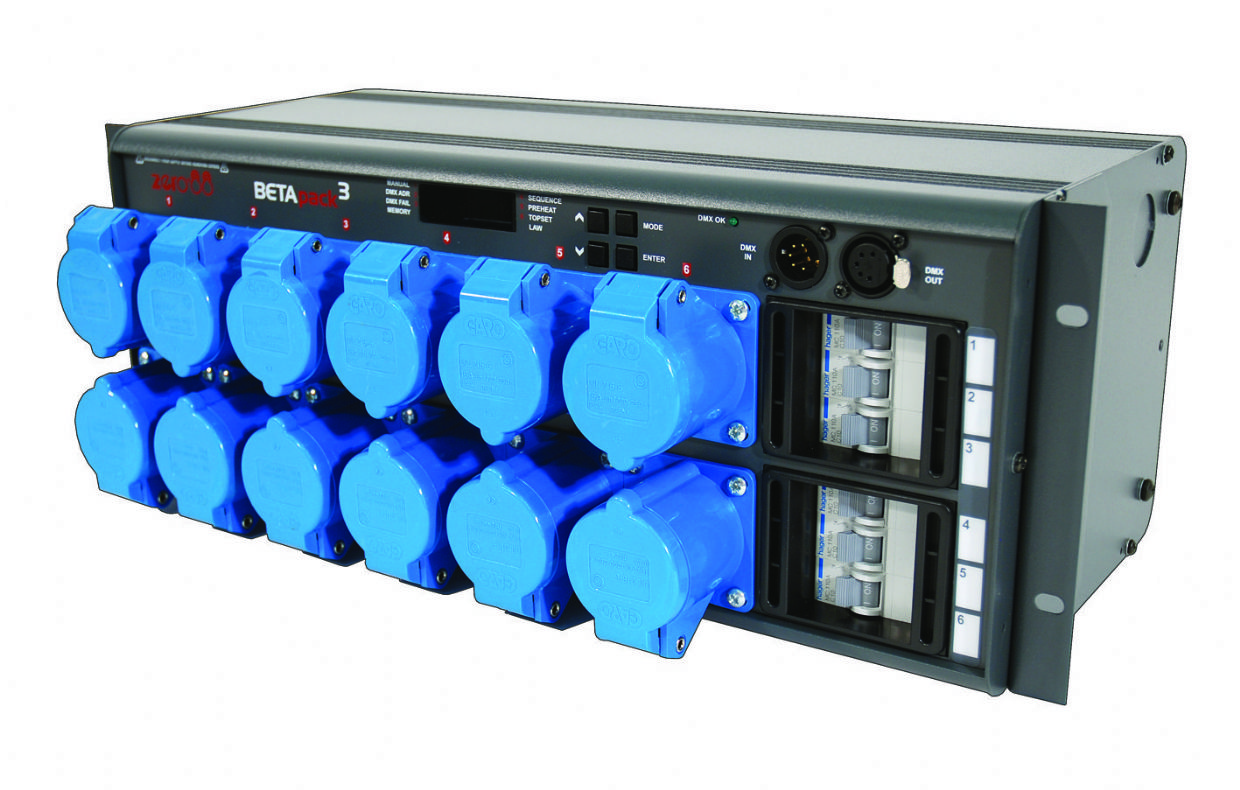
A further advantage of telephone-style patching systems, as mentioned briefly above, is that they allow for specific sockets up on the lighting bars to be connected to constant power, thus allowing for easy connection of intelligent or LED fixtures which are not run off dimmer packs, but contain their own voltage alteration circuitry as discussed in H4.9 - LED Light Fixtures. This connection can simply be accomplished by connecting the patch bay plug (corresponding to the desired bar-mounted socket) to a socket providing constant mains power. Typically, patch bays have a set of hard-wired round-pin sockets providing constant power alongside the dimmer packs in order to allow for this enhanced level of versatility.
If intelligent or LED fixtures are suspended on lighting bars, they will each also require connection to a source of DMX data to control their various different parameters. The most simple manner of accomplishing this is by looping a separate DMX cable emerging from the final dimmer pack along all the fixtures. Since DMX follows a daisy chain topology, the dimmer packs can be addressed and controlled independently of the intelligent fixtures. The presence of a daisy chain does not mean that all the fixtures along the chain act as "clones" of the incoming control signal and cannot each receive dedicated control. For more information regarding DMX control, see Hardware 2: Introduction to DMX Control.
It is important that the DMX daisy chain be addressed correctly in order to allow individual control of all intelligent fixtures and dimmer packs. For more detailed information regarding DMX addressing, see Software 1: DMX Software Operation.
The below diagram clearly shows the way in which a DMX data line (blue) from the main console may loop through the conventional dimmer packs and through intelligent/LED fixtures such that each fixture may receive dedicated control. Note the way in which the same data line as controls the dimmers is also capable of providing dedicated control to each intelligent fixture:
